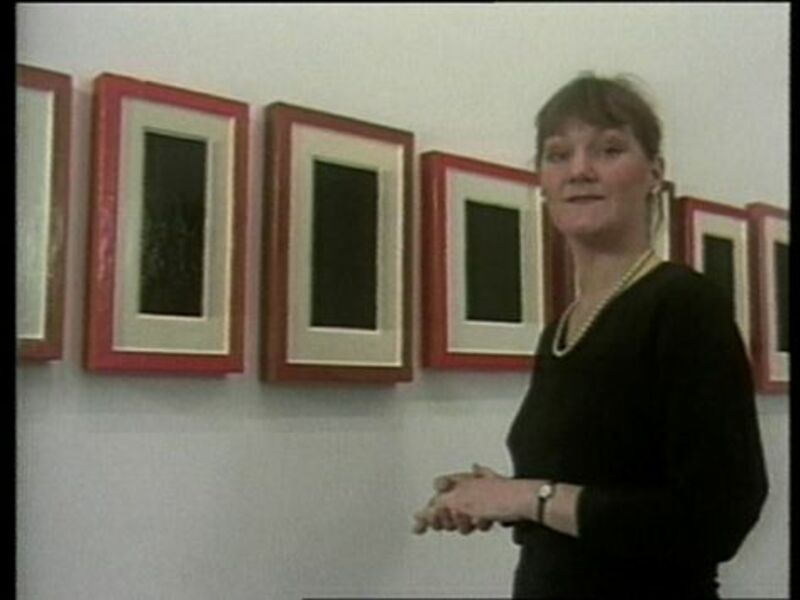Andrea Fraser
Video Gallery
Andrea Fraser is a performance and video artist who is regarded as a pioneer of the conceptually driven artistic practice known as institutional critique. Since the 1980s she has questioned art’s institutional and economic frameworks through humorous, performative interventions that often center on the critical analysis of various art world positions, functions, and educational forms. Her subjects include the docent, the curator, the collector, and the artist, as well as the museum brochure, the exhibition catalog, and the audio guide. This exhibition presents two of the artist’s single-channel video works, May I Help You? (1991) and Little Frank and His Carp (2001), both in the collection of the Mildred Lane Kemper Art Museum.
In May I Help You? an actor in the guise of a gallery staff member at the now-defunct New York gallery American Fine Arts, Co. greets visitors to an exhibition of the artist Allan McCollum’s Plaster Surrogates. Fraser, who wrote and directed the video, instructed the performer to act out a range of reactions to the art on view in a fifteen-minute monologue delivered to everyone who comes in to see the show. During the course of the monologue, the gallery staff member rapidly shifts personas, projecting a range of class positions, cultural critiques, and anxieties onto McCollum’s essentially blank artworks. To produce the script Fraser compiled quotes from auction catalogues, museum guides, and published interviews with dealers, collectors, and artists, including McCollum himself. Fraser exploits the generic, prop-like character of the Plaster Surrogates (examples of which are on view in the Museum’s James M. Kemper Gallery) and how they blur the distinction between reality and artifice, drawing attention to the social context of aesthetic encounters and associated values.
In Little Frank and His Carp Fraser is herself the performer, and the script is the actual over-the-top institutional “voice” of the Guggenheim Museum Bilbao in its visitor audio guide. Shot with hidden cameras, Fraser’s video documents an unauthorized intervention in the museum. During the course of her “visit,” the artist listens raptly as the guide expounds on the glories of the museum’s revolutionary architecture, designed by the world-famous architect Frank Gehry, the “Little Frank” of the video’s title. In what can be described euphemistically as an intense identification with the building, Fraser responds to the tour’s narrative with a variety of exaggerated emotional states. Amplifying and sensualizing the relationship between art and its audiences, Little Frank and His Carp is a send-up of contemporary museological seduction.
About the artist
Andrea Fraser lives and works in Los Angeles, where she is chair and professor in the Department of Art at the University of California, Los Angeles. Her work has been the subject of major retrospectives at Museu d’Art Contemporani de Barcelona (2016); Museo Universitario Arte Contemporáneo, Mexico City (2016); Museum der Moderne Salzburg (2015); and Museum Ludwig, Cologne (2013), among others. Other solo exhibitions and performances of note include those presented at the Hammer Museum, UCLA (2019); Museum Ludwig, Cologne (2017); Whitney Museum of American Art, New York (2016); MAK Center at the Schindler House, Los Angeles (2014); and Carpenter Center for Visual Arts, Harvard University, Cambridge, MA (2010). Andrea Fraser, “What do I, as an artist, provide?” was presented at the Kemper Art Museum in 2007. Her work has been featured in group exhibitions at the Kunstverein für die Rheinlande und Westfalen, Düsseldorf, Germany (2019), and the Contemporary Arts Museum Houston (2018), among others. Fraser was the recipient of the Oskar Kokoschka Prize (2016), the Wolfgang Hahn Prize (2013), an Anonymous Was A Woman Fellowship (2012), and a National Endowment for the Arts Visual Arts Fellowship (1991). In 2016 she wrote and developed Museums, Money, and Politics, a nine hundred–page book that includes the records of political contributions of the board members of more than one hundred US art museums.
Selected works

Andrea Fraser
May I Help You?
1991